As part of the Space and Satellites Artist Residency programme we hosted a series of Work in Progress webinars where each of the artists spoke alongside an academic/scientist about their work. Each of the events was hosted by Inspace Director Dave Murray-Rust.
These events are taking place in June and July, for a full list of talks visit the What’s On section. All webinars are recorded and we will be posting the videos here each week after the event.
Cécile Simonis & Keiko Nomura
In the first of our talks illustrator and visual artist Cécile Simonis talked about her research into how satellites can help us monitor forests. She was joined by Dr Keiko Nomura, a senior analysist from Edinburgh based Space Intelligence.
Project Summary
During this residency, Cécile plans to create a graphic short story printed as an A4 zine and posters whose visual stories use satellite data as well as the science and processes behind the gathering of the data. She would like to use the data in the context of creative narratives, rather than simply providing a literal translation of a set of facts. She doesn’t aim to create obvious educational objects, or propaganda zine, but the facts would provide the baseline for a narrative, valid in its own right. By referencing the data at the end of the zine, the story or stories would fulfil their role as vessel for the facts. The zine and posters will be printed on recycled paper using the risograph process (an eco-friendly printing process using vegetable-based ink with no plastic content). Please see poster below of Cécile’s work in progress.
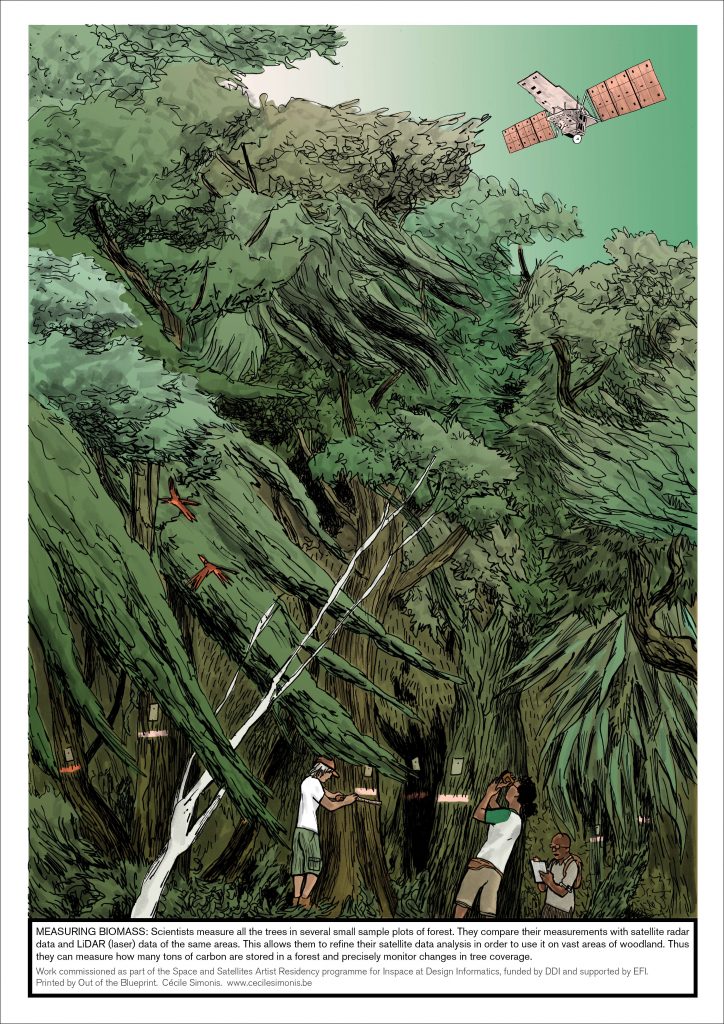
Cécile Simonis
Cécile Simonis is an illustrator and visual artist who has lived and worked in Edinburgh, Scotland, since 2011. She was born in 1984 and grew up in the countryside in the south of Belgium.
She studied in Liège, Belgium and Perugia, Italy and graduated with a Bachelor’s degree in illustration from Ecole Supérieure des Arts Saint-Luc Liège and a Master’s degree in illustration from Ecole Supérieure des Arts de la Ville de Liège (Académie Royale des Beaux Arts). She has taught drawing and illustration in Belgium, Canada and Scotland, including Edinburgh College of Art and the National Museum of Scotland. She makes zines and artists books, drawings, prints, and 3D objects.
Her work has been shown in Scotland, Belgium, Italy, Spain and the Netherlands and has won multiple prizes and awards.
Dr Keiko Nomura
Dr Keiko Nomura works as a Senior Analyst at Space Intelligence. Keiko has a unique expertise combining policy analysis and remote sensing /earth observation. Before coming to Edinburgh, she worked for UNDP and UNEP on REDD+ (Reducing Emissions from Deforestation and Forest Degradation in Developing Countries) in Southeast Asia, where she assessed the readiness of countries participating in REDD+ and provided technical assistance in developing national strategies and communication tools. She was also part of the team that created the REDD+ academy, a capacity development initiative by the UN-REDD Programme, and directly contributed to several modules in the curriculum. Driven by the urgent need for better data in forest monitoring, Keiko left the UN and spent three years in PhD research and successfully developed methodologies to detect forest loss and identify drivers of deforestation with high accuracy and at low costs. At Space Intelligence, she is applying and further developing her skills in land use monitoring as well as for other sectors related to Sustainable Development Goals (SDG).
This talk was hosted by Dave Murray-Rust, Design Informatics and introduced By Caroline Parkinson, Creative Sector Lead, DDI.
Julia McGhee, Geoff Robbins, John McGeoch
In this collaborative residency, dance artist Julia McGhee is working with Geoff Robbins, science technician, and John McGeoch, multi-media artist. Together they are investigating ways of representing distinct sets of satellite data that reflect environmental changes or events in the far North of Scotland, where they are all based. Geoff has been focussing on satellite data available via Google Earth Engine, using this to create animated gif images. Julia has been interpreting environmental change through choreographed and improvised movement, filming herself at home, in her garden and on her local beach. John has been manipulating the filmed movement to create digital animations, abstracting the form of the body to find new ways of presenting their chosen data sets. He has also experimented in making a digital soundtrack by interpreting animated gifs as a musical score.
During this work in progress presentation, Julia, John and Geoff will aim to: share their processes and outputs to date; talk about their next steps in layering data, movement and digital media; and give some insight into the experience of being involved in a multi-disciplinary residency that brings together science and art during lockdown.
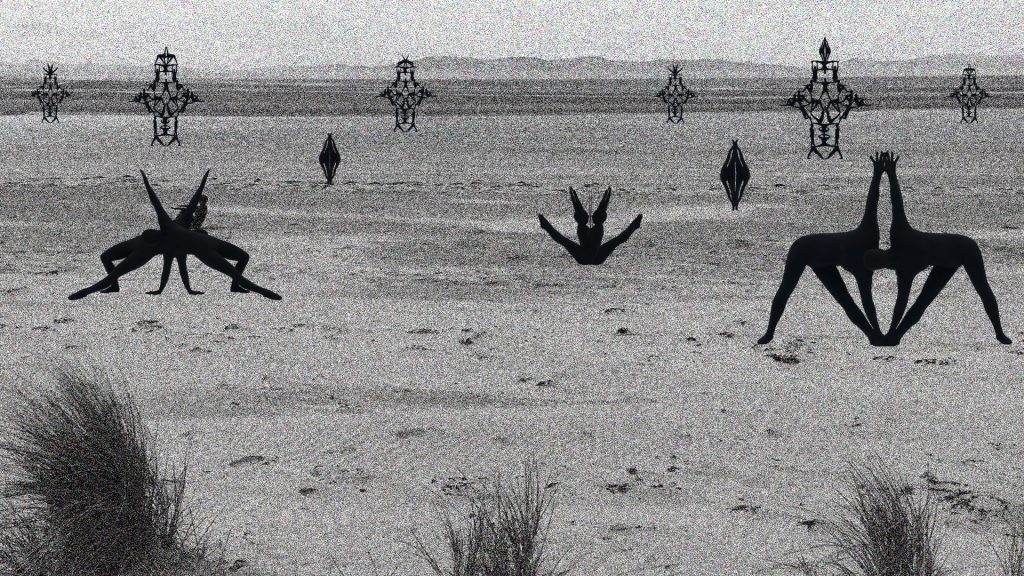
Julia McGhee
Julia is a freelance dance artist who lives and works in Inver, a remote, rural community near Tain in Highland. She creates work in response to her local environment and the people who live in it. She collaborates with other artists to create live performance, dance film and participatory events. Her career as a dance artist spans 12 years working as a performer, choreographer and teacher. As well as her own independent classes, she regularly teaches for arts organisations, community groups and schools. Julia is a member of The Work Room, is a Dance North Regional Artist and in 2017 she was awarded the Janice Parker Projects & Saltire Award. www.juliamcghee.co.uk
Geoff Robbins is the school science lab technician at Tain Royal Academy. He has a background in astrophysics, web development and a broad range of scientific and technical subjects. He builds data bases and provides web development support to a range of artists. His work with data includes a project that searched the first 50 million digits of Pi to find valid ISBN numbers, cross-referencing this with Google Books to find the first three books in Pi. As a coder (Python/Java Script) he will support the team in downloading and interpreting satellite data from EOS Worldview and Sentinel Online.
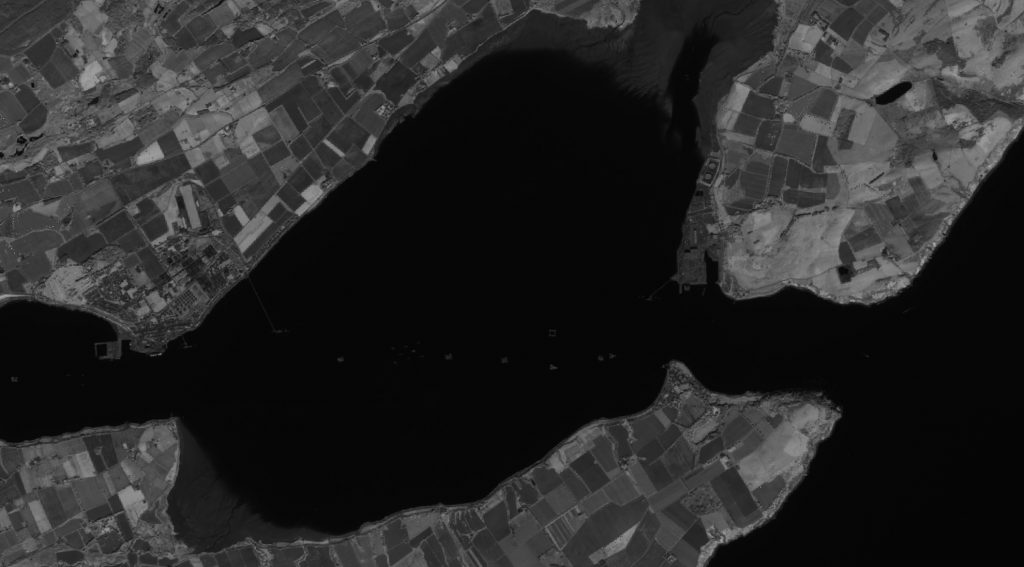
Geoff Robbins
Geoff Robbins is the school science lab technician at Tain Royal Academy. He has a background in astrophysics, web development and a broad range of scientific and technical subjects. He builds data bases and provides web development support to a range of artists. His work with data includes a project that searched the first 50 million digits of Pi to find valid ISBN numbers, cross-referencing this with Google Books to find the first three books in Pi. As a coder (Python/Java Script) he will support the team in downloading and interpreting satellite data from EOS Worldview and Sentinel Online.
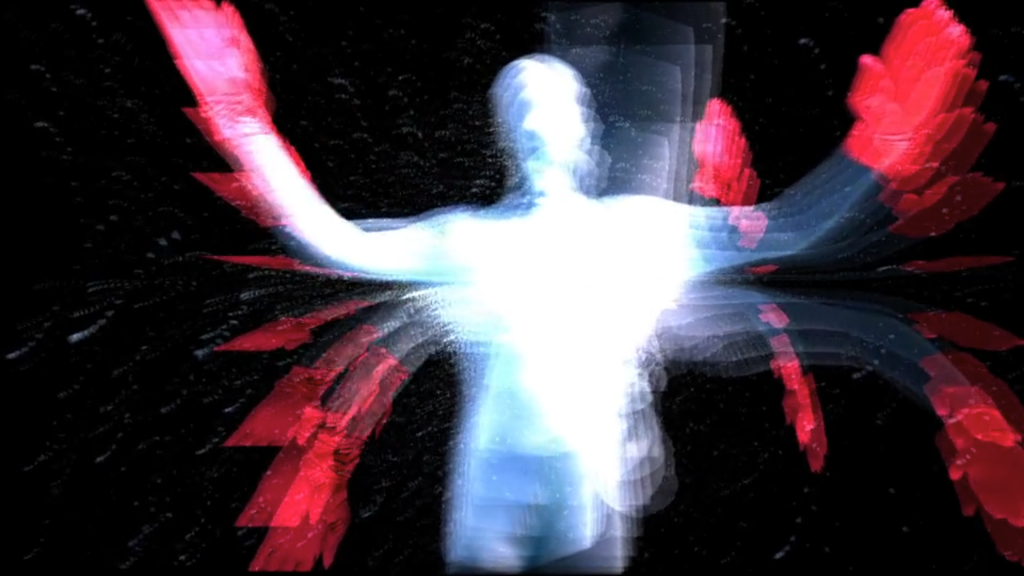
John McGeoch
John McGeoch has been working in the arts since the early 80`s progressing through street theatre to touring theatre to multimedia. He is currently mostly involved in animation and mapped projections. He ran Arts in Motion and its performance production space for over fifteen years. He particularly enjoys collaborations and work with artists of many disciplines. He also runs a steampunk venue at Belladrum Festival and runs the sets and projections for Inverness Halloween on the Islands. Currently in lockdown he is working on a few small projects with Australian artists and creating an archive of past work. https://vimeo.com/user2338864
John McGeoch has been working in the arts since the early 80`s progressing through street theatre to touring theatre to multimedia. He is currently mostly involved in animation and mapped projections. He ran Arts in Motion and its performance production space for over fifteen years. He particularly enjoys collaborations and work with artists of many disciplines. He also runs a steampunk venue at Belladrum Festival and runs the sets and projections for Inverness Halloween on the Islands. Currently in lockdown he is working on a few small projects with Australian artists and creating an archive of past work. https://vimeo.com/user2338864
Elaine Ford & Connie Tremlett
In the third of our talks Elaine Ford, visual artist, talked through her work exploring the use of satellite technology for the conservation of wildlife and natural habitats. As part of this unique science-art collaboration, Elaine partnered with world-leading conservation charity the Royal Society for the Protection of Birds who joined her for the talk focussing on Project Puffin.
Traditional field biology relied on surveys on the ground. Satellite data now enables scientists to perceive the movement of animals, and the environment which they inhabit, in new and exciting ways. Global Positioning System (GPS) data and Earth Observation imagery provide new dimensions to our understanding of the animate earth, changing our perspectives of the natural world and its intricate dynamics across time and space. Exploring the connections between biological and physical processes, Elaine is using GPS data to visualise and interpret the lives of charismatic Puffins on the islands and seas of northern Scotland. Connecting animals with the unseen morphology of planet Earth by harnessing bathymetric data, Elaine has collaborated with satellite data analytics company Space Intelligence and Ray Interactive to create data visualisations that act as signatures in time by creating portraits of flight. Elaine is experimenting with these data visualisations to inform and create a new layer of interpretation, by growing salt crystals to draw in space, reflecting the fragility of our ocean ecosystems. The work explores impermanence and the inexorable interconnections between physical and biological processes of our living planet.
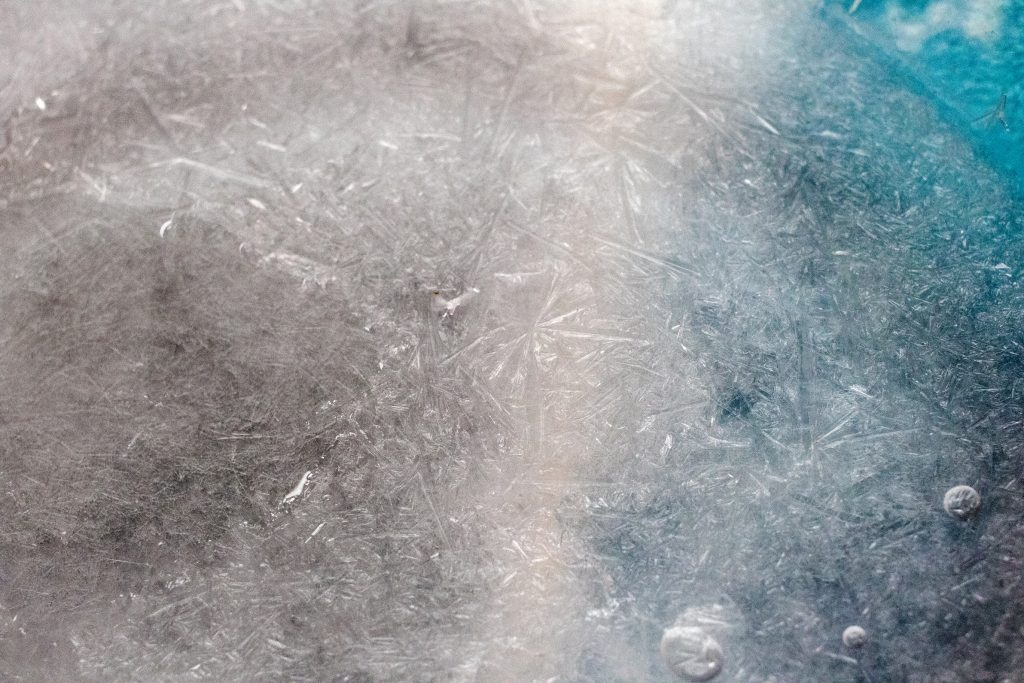
Elaine Ford
Elaine has produced multidisciplinary artwork using glass sculpture, installation, and painting. With a BSc in Biology with Ecology (integrating MSc Tropical Biodiversity), and a BA in Fine Art with Digital Crafting in Glass from Edinburgh College of Art. Elaine is exploring the interplay between science, technological innovation, biodiversity conservation and adventure. Her work focuses on the creation of immersive experiences that transport the viewer to remote locations, to engage with wild landscapes, diverse cultures and rare species. In collaboration with Wild Immersion, she has exhibited immersive content in Paris, Los Angeles, at Burning Man and at home in Edinburgh. These film and photographic techniques are developing her practice in time-based art. Elaine is currently developing a long-term project exploring the application of 360 film-making techniques in the Okavango Delta, to help diverse communities around the world experience wildlife up-close and engage with the latest conservation issues.

Connie Tremlett from the RSPB
Puffins are an iconic and much-loved UK seabird, but sadly are vulnerable to global extinction. One likely factor causing population declines is changing food availability, but there is little data on puffin diet that spans the whole of the UK. Project Puffin was launched in 2017 to help fill this knowledge gap, asking the public to submit photos of puffins carrying fish, which are then identified and counted by a team of volunteers. GPS tracking data was also collected from some puffin colonies. The combination of the diet data and the tracking data gives a valuable picture of what food puffins are finding, and how.
Victoria Evans
In the fourth of our talks Victoria Evans, contemporary artist, talked through her work exploring the communications between satellites in her project ‘Deep Space Call and Response’. She was joined by collaborator Matthew Reed from the European Space Agency and also Sam Healy and Brendan McCarthy from Ray Interactive.
The satellites that orbit our planet or extend deep into space are capable of collecting huge swathes of data relating to a range of human concerns: those that are immediate and pragmatic – such as monitoring changes in air pollution or the melting of Arctic sea-ice; as well as those that are more distant and esoteric – such as mapping the dynamics of a black hole or a supernova. But how do we actually keep in touch with these tiny craft in the vastness of space? And how do they communicate the information they have gathered back to us on earth?
Victoria has been working with data from the European Space Agency (ESA) to uncover the patterns of ongoing communication between twelve space missions and the network of ground stations that support them. Victoria is using a process of data sonification (the use of non-speech audio to perceptualise information) to make their movements and communicative rhythms audible. She hopes that, through using sound as the primary medium for the artwork, these complex interactions can be experienced in a new way. ‘Deep Space Call and Response’ aims to highlight, poetically, the co-operative networks that lie behind the data, and that allow us to extend our perception out into the solar system and beyond.
Victoria will talk about how the collaboration with Matthew Reed (Space Operations Centre at ESA), Sam Healy (Creative coding at Ray Interactive) and Richy Carey (Sound designer) has shaped her artistic process and about why she was drawn to this particular scientific subject.
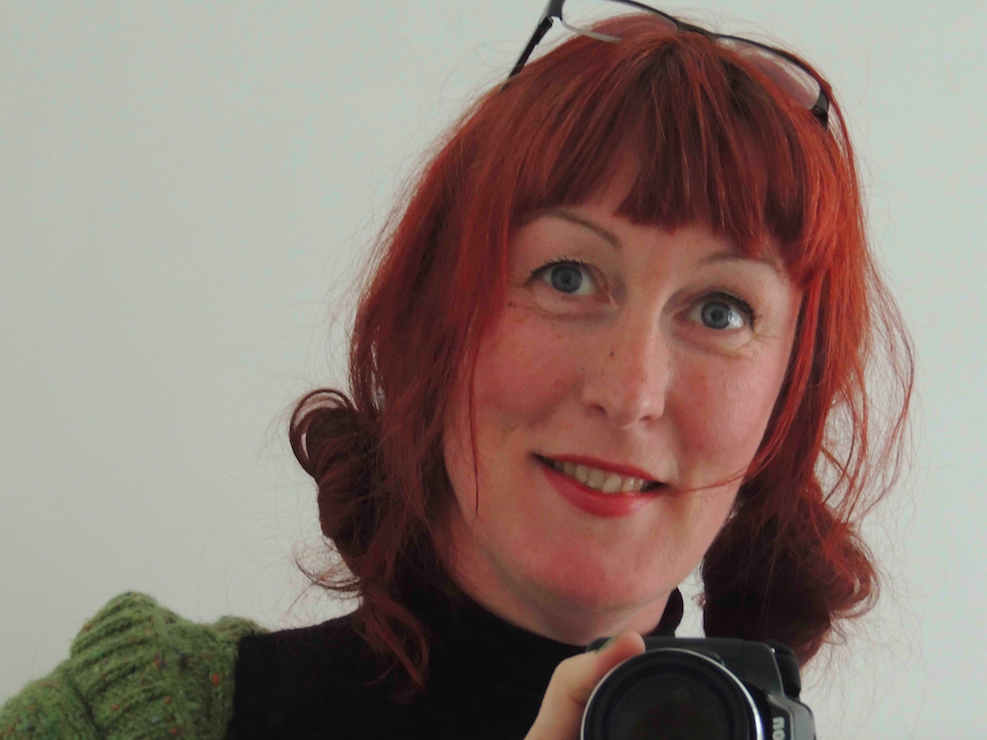
Victoria Evans works across a shifting combination of moving image, sound, sculpture and installation. Her PhD studies explore how the theories of agential realism and distributed cognition can be employed to expand the field of creative research, within the practice of moving image installation. One of the strands of this research involves the sonification of data to create novel audience experiences relating to man-made and environmental cycles. Victoria works across a shifting combination of moving image, sound, sculpture and installation. Her PhD studies explore how the theories of agential realism and distributed cognition can be employed to expand the field of creative research, within the practice of moving image installation. One of the strands of this research involves the sonification of data to create novel audience experiences relating to man-made and environmental cycles.Victoria works across a shifting combination of moving image, sound, sculpture and installation. Her PhD studies explore how the theories of agential realism and distributed cognition can be employed to expand the field of creative research, within the practice of moving image installation. One of the strands of this research involves the sonification of data to create novel audience experiences relating to man-made and environmental cycles.

Matthew Reed is ESTRACK Planning Officer at the Network Operations Centre at the European Space Agency (ESA) in Darmstadt, Germany. His role is to ensure that ESTRACK, the network of ground stations used to communicate with space craft, are configured correctly for all ESA supported missions, including those for external agencies such as NASA, JAXA and ISRO etc..
Ray Interactive. Interactive Art and Design Studio with a focus on generative design, creative coding and live interactive experiences. Ray Interactive have been supporting all of our artists throughout the residency process in both getting to grips with the data and helping with visualisations.
Stacey Hunter, Ben Hymers & Roy Thompson
In the last of our talks curator Dr Stacey Hunter, and weaver Ben Hymers, talked through their data-derived tapestry project ‘EVERYONE: Making data tangible through material cultures’. Stacey and Ben were joined by their scientific collaborator Professor Roy Thompson, an environmental geophysicist. The team also includes data visualisation designers Sam Healy and Brendan McCarthy of Ray Interactive and air pollution modeller Dr Massimo Vieno of UKCEH.
Sitting at the intersection of craft, science and design, EVERYONE considers the environmental impact of Covid19 lockdown on Edinburgh through the medium of a large scale tapestry. The global impact of Covid19 has not only overridden our familiar routines and preoccupations, it has in effect created a giant natural experiment. We were interested in how to take this unique opportunity — where whole new datasets have been unexpectedly created, where we have the opportunity to coax nature into helping us understand the natural world and ourselves better — and to record it using the historic traditions of weaving.
EVERYONE examines data sets derived from three separate vantage points: global, regional and local. The project has created a narrative about the impact of lockdown in relation to climate and environmental change. The piece explores, in an aesthetic sense, how data can be abstracted and made figurative by layering of images and experimenting with scale. It illustrates the power of the handmade and digital processes in conveying – to use the words of world renowned Scottish weaver Archie Brennan – “concept, comments, harmony, discord, rhythm, growth and form”.
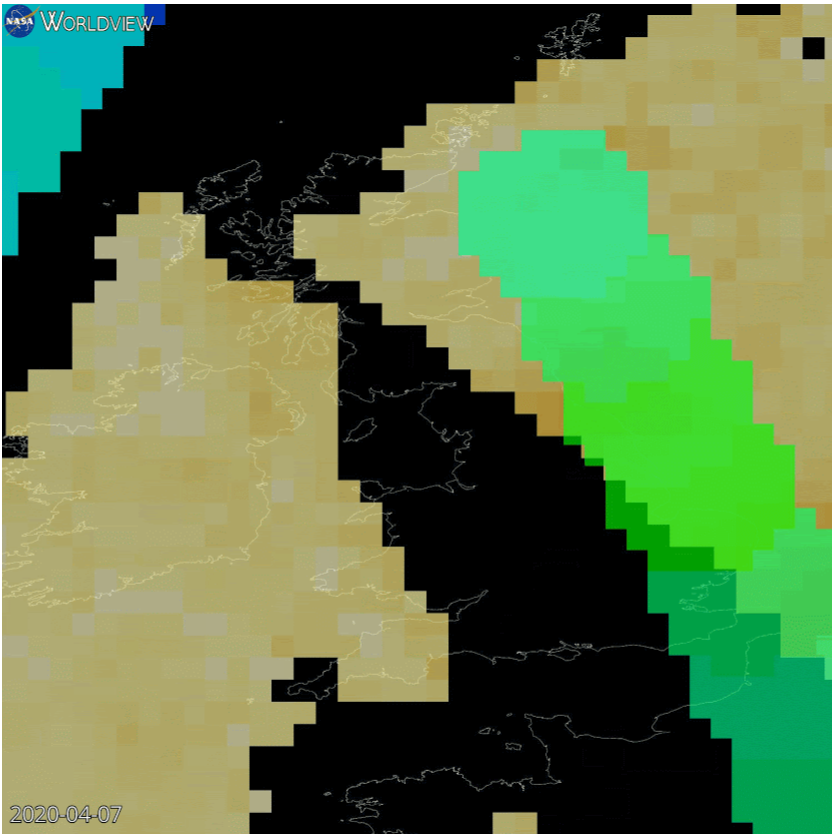
Dr Stacey Hunter curates, writes and produces within a design context; her collaborative exhibitions and projects are known and appreciated for their unconventional approach and broad appeal. She is committed to the development of contemporary design culture in Scotland and enlivening design and craft discourses. In 2015 she founded Local Heroes to present the work of outstanding designers working in Scotland. She collaborates with a diverse range of organisations from airports and art hubs to hotels, hospitals and business associations. In 2017 V&A Dundee named her one of their Design Champions; in 2018 she won Creative Edinburgh’s Leadership Award and in 2019 she was selected by Cove Park to visit Japan for 2 months as design curator in residence at Arts Initiative Tokyo and Creative Residency Arita. Her PhD in Architecture was awarded by The University of Edinburgh in 2015.

Ben Hymers is a Weaver and Rug Tufter who has worked on several high-profile projects, designs and exhibitions for Dovecot. He holds an MA (Hons) History of Art degree from the University of Edinburgh, studied Classical Painting Techniques at the Michelangelo Institute in Florence, and time-travelled in Channel 4’sBAFTAnominated 1940s House. Interested in the classical and the magical, Ben is also a Close-up Magician and his work champions the importance of traditional arts and crafts practices in an increasingly digital and distant society.
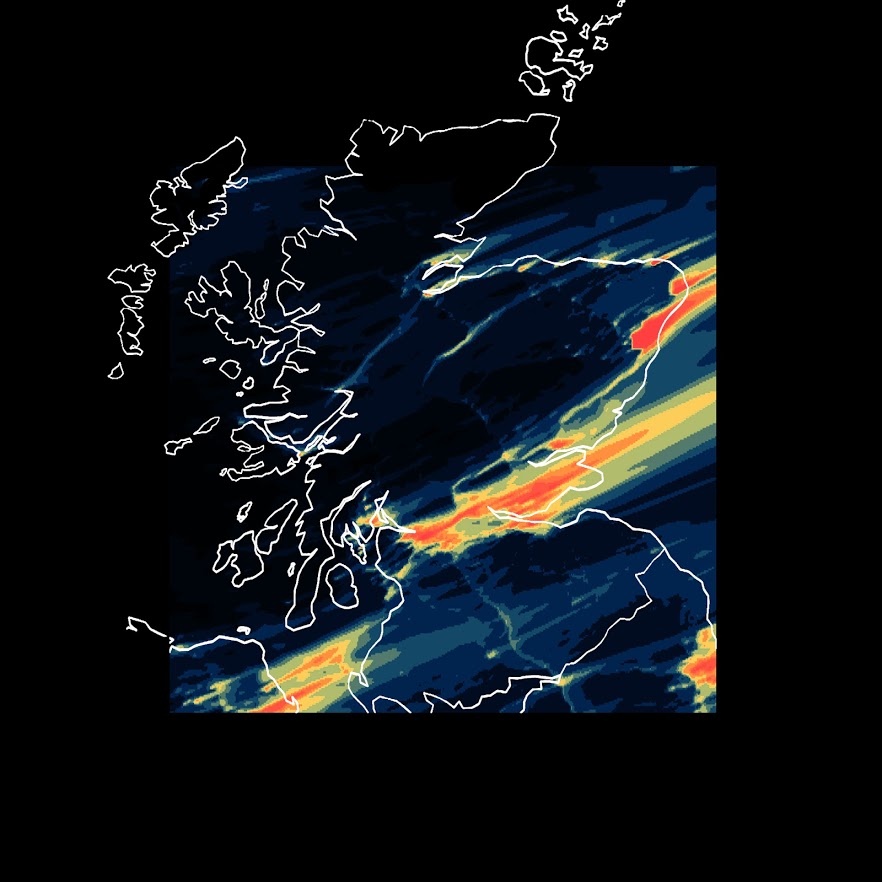
Prof Roy Thompson taught geophysics at Edinburgh for 35 years; established the Geophysics & Meteorology degree; set (and marked!) more than 1600 different exam questions; and published two books and 150 peer-reviewed scientific papers before retiring from GeoSciences in 2008. Over the years his research interests moved steadily outwards from the Earth’s core to its atmosphere. They began with the geomagnetic field (generated in the core), followed by plate tectonics (driven by mantle convection); surface processes (particularly environmental magnetism); palaeoclimate (lake-sediment records); and more recently atmospheric modelling. His current interests focus on interpreting the iconic carbon dioxide time-series taken atop Mauna Loa; on the key global warming parameter of climate sensitivity; on developing a new climate-economics model; on air-pollution, on fracking; and on Geddes’ vision of the evolution of cities.